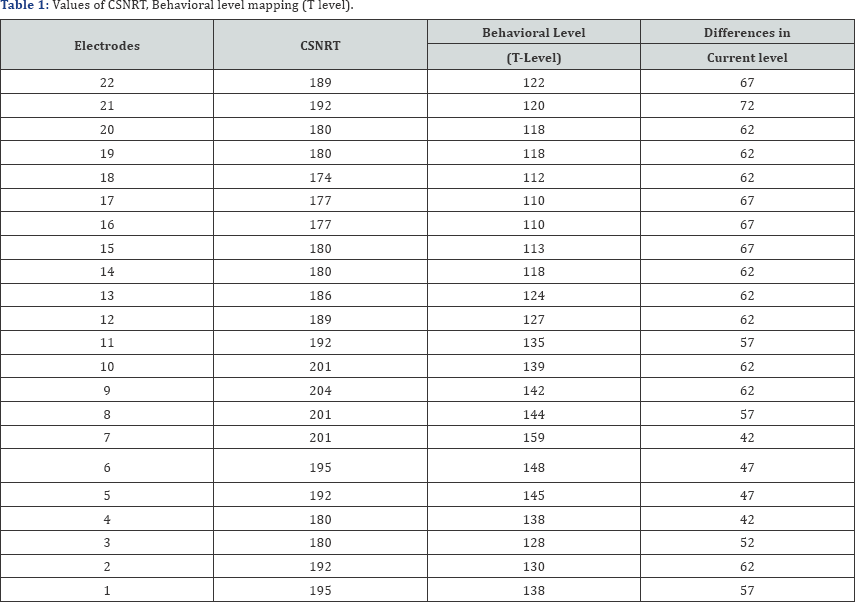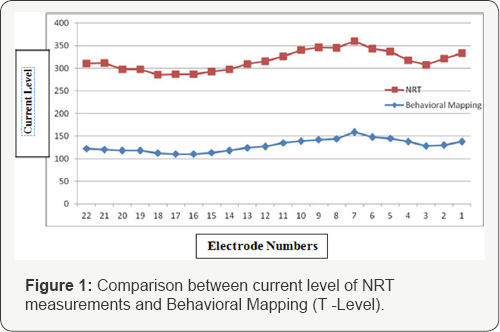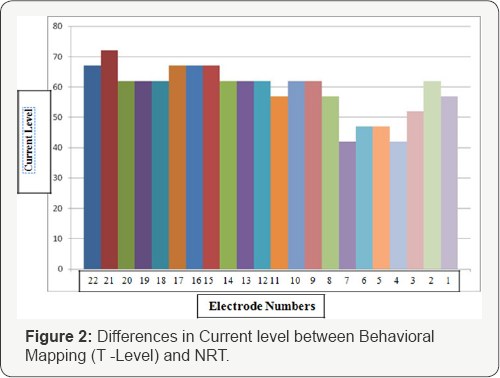A Comparative Study on the Differences between NRT and Behavioral Mapping in Cochlear Implant - A Single Case Study
Pradeep VR*
Department of Cochlear Implant, India
Submission: July 18, 2017; Published: August 09, 2017
*Corresponding author: Pradeep VR, Department of Cochlear Implant, India, Tel: 9543217409; Email: prad.vr@gmail.com
How to cite this article: Pradeep VR. A Comparative Study on the Differences between NRT and Behavioral Mapping in Cochlear Implant-A Single Case Study. Glob J Oto 2017; 9(4): 555768. DOI: 10.19080/GJO.2017.09.555768
Abstract
Introduction: Objective and subjective measurement play a major role while mapping. Objective measurements are carried out in both intraoperative and postoperative. These measurements helps to check, whether all electrodes functions correctly. The Custom Sound Neural Response Telemetry (CSNRT) helps clinician while mapping/programming speech processor in children. But in adult’s behavioral response play a vital role in setting (T) Threshold level.
Aim: The aim of the study is to measure the difference in current level between Neural Response Telemetry (NRT) and Behavioral response mapping during the switch on of a post lingual cochlear implant adult.
Methodology: A post lingual adult aged 36yrs/F, implanted with cochlear CI422 (ST) in the right ear has been considered for the study. The Neural Response Telemetry (NRT) values are measured for all the 22 electrodes with Custom Sound software 4.1.This was followed by behavioral mapping for all the 22 electrodes.
Result: On comparing NRT and behavioral mapping values we could find lot of differences in current level. During statistical analysis we observed a significant difference between Custom Sound Neural Response Telemetry (CSNRT) & Behavioral mapping (T) Threshold level.
Conclusion: In adults behavioral response should be given primary choice while mapping to obtain T (Threshold) level. CSNRT can be used for mapping primarily in children but not in adults. The limitation of the study is that it is a single case study. In future we need to carry out similar studies with larger population.
Introduction
Hearing is considered as an important sense for human life. Such as precious sense is damaged it is very difficult to lead normal life. Cochlear implant (CI) is a miraculous technology which is available to restore normal hearing for Severe to profound hearing loss individuals. The selection criteria for CI ranging different age group start from 6 months of age to an adult. It includes pre lingual, post lingual children & adult and partial high frequency hearing loss. People who are not getting much benefit with digital hearing aids, mainly to understand speech are becoming the most suitable candidate for post lingual Cochlear Implants [1].
In CI starting from the base electrode to apex electrode all 22 electrodes are stimulated directly by electrical current which trigger the auditory nerve which makes the CI candidates hear. The amount of the electrical current necessary to trigger an auditory sensation is different for each individual and for each stimulation channel. Therefore, the speech processor must be individually adjusted together with each stimulation channel for each user and this process is called mapping [2]. In adults behavioral response play a major role in mapping speech processor. Each specific electrodes required specific amount of energy to trigger the specific area in the Cochlea. The Threshold (T- level) is set by an audiologist based on minimum current level in which CI candidate is detecting while programming and C- level is set based on maximum current level accepted by the CI individuals without any discomfort [3].
The Custom Sound Neural Response Telemetry (CSNRT) is an objective measurement helps the clinician while programming speech processor exclusively for children. It is very easy to obtain Threshold & Comfort level for adult based on their cooperation. One of the important challenging task and unsolved problems is for children. In current situation various tools has been proposed for an objective study including electrical stapedius muscle reflexes, electrically evoked auditory brain stem response and more recently, the evoked auditory action potential (EAP) measured using the Nucleus 24 cochlear implant [4]. A lot of scientific studies have been carried out by various researchers in field of CI exclusively on the correlation between the neural response threshold and the behavioral mapping. But the results are varying based on its limitation and various other parameters. Important things which are followed by the Audiologist professionals in CI is the NRT threshold be used to approximate T- and/or C-level remains.
Materials and Method
A post lingual adult aged 36years/female with Severe to Profound hearing loss in both ears have considered for the study. Initially she has undergone detailed assessment of ENT assessment and Audiological testings. The audiological evaluation including Pure Tone Audiometry, Speech Audiometry, Oto Acoustic Emissions, Brain stem Evoked Response Audiometry (BERA), Aided audiogram with different digital powerful behind the ear hearing aids. The candidate also underwent radiological procedures like high resolution CT scan and MRI scan to detect any congenital deformities of the cochlea and eighth cranial nerve. From the evaluation it was revealed that no anomalies in structures of Cochlea, Semicircular Canal and the Auditory nerve. Above all findings supports she is the perfect candidate for CI.
She was implanted with cochlear CI422 (ST) device in the right ear had full insertion and activation of the electrode array. The Neural Response Telemetry (NRT) recordings were checked in operating rooms to confirm its working. The recordings obtained at the end of the implant operation after the surgeon placed the skin over the implanted device using software with Custom Sound software 4.1 with the speech processor to capture, process, store and display the measurement data on a laptop. The switch on and speech processor tuning was done 4 weeks after surgery. Neural Response Telemetry (NRT) and Behavioral response mapping during the switch on was carried out. The behavioral responses were recorded as minimum sound was hear by subject when the electrode was stimulated through Custom Sound Software.
Results
On comparing NRT and behavioral mapping values we could find lot of differences in current level. CSNRT was carried out for all 22 electrodes starting from the base toward the apex electrodes in the cochlea. In Table 1 represents the CSNRT level, behavioral levels (T-Level) and differences between theses current levels for all electrodes respectively. During statistical analysis we observed a significant difference between Custom Sound Neural Response Telemetry (CSNRT) & Behavioral mapping (T) Threshold level. The comparison between current levels for the Behavioral Mapping level (T -Level) and NRT level measurements were as presented in Figure 1. At each electrode number, the level for T-level and NRT level differed significantly. The p-value is <.00001 and the result is significant at (p <0.05. One-Way ANOVA).


In the Figure 2 it is clearly explains that comparing the CSNRT and Behavioral mapping levels of electrode from 22 to 11 number which are present in base to first turn areas of cochlea there is a difference of more than 60 Current levels were observed. But from electrodes from 10 to 1 there is a little variation of current level from minimum of 42 and maximum of 62 current levels of apex electrodes. In overall there is a huge difference in current level of Behavioral mapping compare to CSNRT current level. This results support that always in post lingual adult behavioral mapping should be carried out to set better threshold level (T- Level) instead of CSNRT levels are used as reference values to set T level.

Discussion
In the current study during the time of first switch on NRT was compared with behavioral response. During regular usage of CI the difference in current level is going to increase gradually. According to current statistical analysis it can be assumed there is going to be large difference between NRT and behavioral mapping over coming time. In comparison of CSNRT and Behavioral response values difference of more than 60 current levels were observed. This differences were observed in basal and mid part of cochlear region. In the apical region of the cochlea only 45 current levels were only measured.
Above data clearly supports behavioral response mapping play a vital role in mapping speech processor when compare to NRT measurements. The present study therefore implies that behavioral response mapping is not only a important clinical tool in providing information regarding integrity of the implant and status of peripheral auditory nerves but can also be used in programming the speech processor for recipients. Across the electrodes it is statically proved that there is a significant difference between CSNRT and Behavioral response mapping. The current study support that for all post lingual adults it is essential to carry out behavioral response mapping in order to get accurate threshold levels for better mapping (program in speech processor).
Conclusion
NRT is considered an important role in programming Speech processor in CI. This study support extensively behavioral mapping plays a key role in programming CI. Current study was carried out as single case study in future it should be carried out in large population in adults in order to get better correlation results and consistency.
References
- Raghunandhan S, Ravikumar A, Kameswaran M, Mandke K, Ranjith R (2015) Electrophysiological Correlates of Behavioral Comfort Levels in Cochlear Implantees: A Prospective Study. Indian J Otolaryngol Head Neck Surg 67(3): 210-222.
- Thai-Van H, Truy E, Charasse B, Boutitie F, Chanal JM, et al. (2004) Modeling the relationship between psychophysical perception and electrically evoked compound action potential in young cochlear implant recipients: clinical implication for implant fitting. Clin Neurophysiol 115(2811-2824).
- Gordon K, Papsin BC, Harrison RV (2004) Programming cochlear implant stimulation levels in infants and children with a combination of objective measures. International Journal Audiology 43(528-532).
- Brown (1999) Relationship between NRT and behavioral threshold and comfort levels. European Custom Sound Seminar June (Sintra).





























